Proper closing of the glass tempering furnace is a critical aspect of equipment maintenance that should not be neglected.
The process of shutting down the furnace, whether for a short-term pause in production or a long-term shutdown, is essential to ensure the safety of the equipment, prevent potential damage and maximize its life and efficiency.
When it comes to closing a glass tempering furnace, attention to detail is essential. It is important to follow a systematic approach to ensure that all necessary steps are taken to properly prepare the furnace for shutdown. This includes turning off the furnace’s power supply, allowing it to cool gradually, cleaning internal and external surfaces, inspecting and replacing damaged heating elements, and securing all doors and vents to prevent dust and waste in the oven during shutdown.
Considering that many companies have reached the possible limit of working hours for the machine, they should consider these steps and adhere to the manufacturer’s instructions and recommendations, in order to help maintain the efficiency and performance of the glass tempering furnace:
Short-term Production Stop:
When planning a short-term production stop, the first step is to activate the temperature switch through the glass tempering furnace’s control interface. Depending on the expected downtime, it is important to set an appropriate insulation temperature for the furnace. By doing so, the control system will automatically adjust the furnace temperature to a lower state, ensuring a safe cooling process during the pause in production.
Long-term Production Stop:
For a long-term production stop, a more detailed shutdown procedure is required to safeguard the glass tempering furnace:
1. Set the heating temperatures of both the upper and lower parts of the glass tempering machine to 0 degrees Celsius.
2. Disconnect the heating switch in the control interface and turn off the heating switch of the control cabinet to allow the furnace to cool down naturally.
3. Monitor the temperature changes within the furnace closely. It is crucial to wait until the furnace temperature drops below 300 degrees Celsius before stopping the main drive rotation. This precaution prevents any deformation of the ceramic rollers due to high temperatures.
4. After halting the main drive, proceed to shut down the industrial computer. Sequentially disconnect the sub-circuit power supply and the control system power supply of the glass tempering furnace.
5. The blower system can be turned off at any time when not in use to reduce energy consumption and ensure efficient operation.
By following these specific operational recommendations provided by LandGlass, glass tempering furnace operators can effectively and safely shut down their equipment, prolonging its lifespan and maintaining optimal performance. Properly cooling down the furnace after use is not only essential for equipment maintenance but also contributes to a safer working environment for operators. Adhering to these best practices will help ensure the longevity and efficiency of glass tempering furnaces in industrial settings.
Source:LandGlass with additional information added by GlassBalkan







